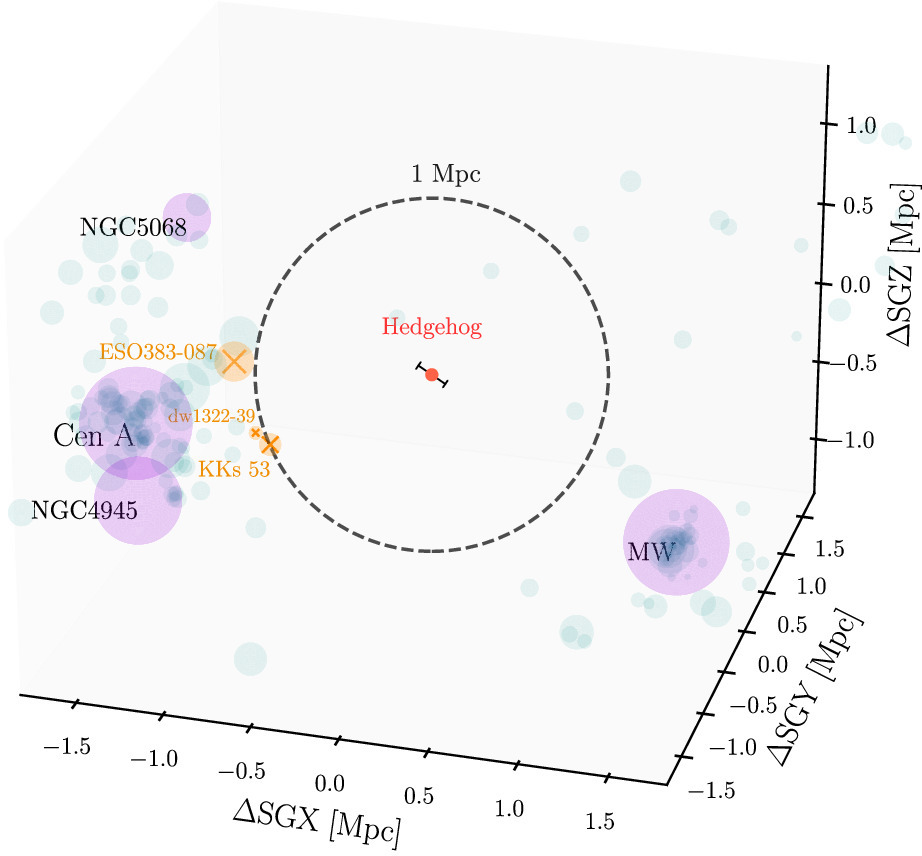At just 7.8 million light-years away, the newly discovered dwarf galaxy dw1322m2053 is remarkable for its isolation and lack of star-forming activity. If that wasn’t enough to make you anthropomorphize it and feel sorry for its lonely status, the astronomers who found it have nicknamed it “Hedgehog”.
We have detected galaxies billions of light-years away, so one might expect the local universe out to at least 10 million light-years would be thoroughly mapped out. For a variety of reasons, however, that is not the case, and galaxies like Hedgehog have remained unnoticed until now. Although relatively nearby dwarf galaxies are discovered now and then, finding one as distinctive as Hedgehog is a different matter.
Exposure to the gravity of larger galaxies frequently disrupts the gas in dwarf galaxies. Some undergo dramatic bursts of star formation that can exceed activity in many larger galaxies. It’s not entirely a coincidence that we saw a supernova in the Large Magellanic Cloud (LMC) far more recently than one in the Milky Way, and the most massive stars we know are also overwhelmingly in the LMC.
Hedgehog, however, is at the other extreme. Instead of just a few Milky Way-lengths away, like the Magellanic Clouds, Hedgehog is 3.3 million light years from the nearest galaxy, and 2.2 million more from a galactic group.

Hedgehog (dw1322m2053) as seen at optical and near-infrared wavelengths (left and center images) but there’s nothing but background stars in in the ultraviolet (right image)
Image Credit Li et al/Astrophyisical Journal Letters
Many dwarf galaxies are quiescent (have stopped forming stars) because the gas that would have been the raw material for star formation was stripped in encounters with larger galaxies, or used up in previous bursts.
On the other hand, just 6 in 10,000 known isolated dwarf galaxies are quiescent. With nothing nearby to cause such violent disruption, they usually just keep on forming stars at a relatively steady rate. Then again, we may have a skewed sample – if a dwarf galaxy is both small and lacking in hot young stars, we might just be overlooking it.
Princeton University graduate student Jiaxuan Li (李嘉轩) was part of a team seeking dwarf galaxies orbiting the spiral galaxy NGC 5068 when they discovered Hedgehog. At an estimated 17 million light-years away, NGC 5068 is a good distance to have undiscovered dwarf companions that are still close enough for in-depth study.
Despite being in the right direction, dw1322m2053 didn’t seem to fit, and the team thought its strange patterns might mean it was close enough we were seeing individual stars or clusters. Examination with a larger instrument revealed dw1322m2053 produced an estimate of, just 7.8 million light years away.
Our local group of galaxies are not dw1322m2053’s nearest neighbors, that status goes to fellow dwarf KKs 53 at the edge of the group containing the huge elliptical galaxy Centaurus A.

The location of Hedgehog in relation to the Milky Way, NGC 5068, and Centaurus A and its neighbors.
Image Credit: Li et al/ Astrophysical Journal Letters
Dw1322m2053 appears invisible in the ultraviolet part of the spectrum, indicating an absence of young stars, and no dust lanes behind which such stars could be lurking were detected. In fact, Li and colleagues think there has been no new star formation in Hedgehog for at least 100 million years, and possibly five billion. The last time this galaxy formed a star not only were there no hedgehogs, there were barely mammals, and it’s even possible there was no life on Earth.
The immediate thing astronomers want to know is why Hedgehog is quiescent. Li and colleagues think it is most likely a “backsplash galaxy,”, one that passed through a group and had most of its gas stripped away, leaving it with little material to form new stars. The remnants were then flung into the void by the gravity of larger objects.
If this sounds like the behavior of a cosmic tyrant, be warned: Centaurus A is the prime suspect for such bullying, but the Milky Way isn’t that much more distant, so any “cruelty to galactic hedgehogs” inspectors might not cross us off the list. Further research on Hedgehog’s age and movements will be necessary to determine if it’s a backsplash galaxy, and if so, who is responsible. It’s estimated that if expelled by the Centaurus A group of galaxies, it would have taken 4-6 billion years to reach its current location.
It’s also possible dw1322m2053 is so small (around 630,000 solar masses) that it lost its gas in some other way, such as a small number of supernovae driving remnant gas out a long time ago.
Either way, its distinctiveness makes Hedgehog worth studying as a point of comparison, so it’s handy it is so close – 12 times closer than another recently discovered isolated quiescent dwarf galaxy.
If you’re wondering about the name, it’s not because dw1322m2053 looks like a hedgehog. Frankly, it doesn’t look like anything much. The authors say it is because hedgehogs are “small and solitary animals.”
The paper is published open access in The Astrophysical Journal Letters.
Source Link: Newly Discovered “Hedgehog" Galaxy Might Be The Loneliest In The Known Universe